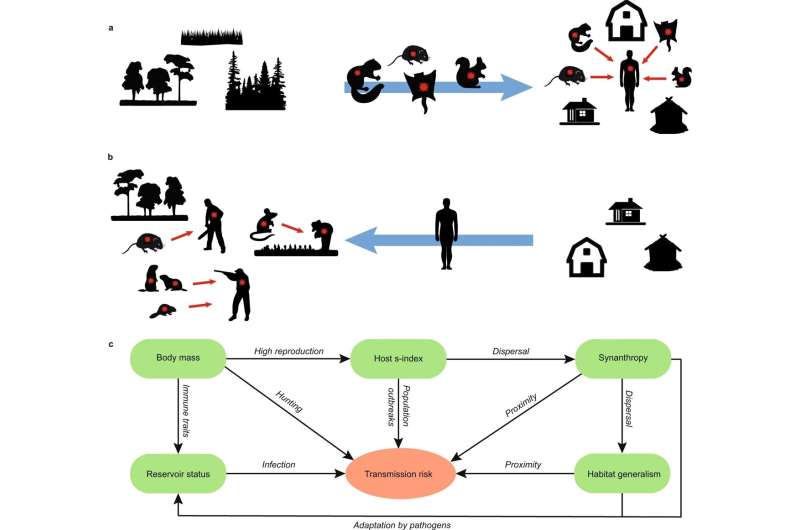Why humans get infected with rodent-borne diseases

The COVID-19 pandemic has stressed the need to better understand the transmission routes of animal-spread diseases. A study published in Nature Communications demonstrates how the risk of pathogen transmission from rodents to humans is driven by the interplay between natural and human-caused factors.
Rodents' "fast life" with sexual maturity at early age, many litters per year and numerous young per litter offer an explanation as to why rodents are important reservoirs for pathogens. But why do humans get infected by rodent-borne pathogens?
"Most rodents that spread zoonotic pathogens, meaning pathogens spreading between animals and humans, show large population fluctuations, move at least occasionally indoors, or are hunted for meat or fur. Our results were consistent among pathogen types (i.e., virus, bacteria, fungi, and parasites). And also with transmission modes, i.e., intermediate, involvement of vectors or non-close and close contact, with close contact including inhalation of contaminated aerosols," says Frauke Ecke, project leader and Professor at University of Helsinki, Finland and senior lecturer at Swedish University of Agricultural Sciences (SLU).
Global study on 436 rodent species
In the study published in Nature Communications, researchers from SLU, University of Helsinki and Cary Institute of Ecosystem Studies, U.S., performed a global quantitative study based on data collected from research papers and databases.
The study includes 436 rodent species of which 282 are all known reservoirs of zoonotic pathogens. The researchers studied the linkage among the rodents' choice of environment, variation in numbers (e.g., population fluctuations and humans' hunting of rodents), and the status of rodents as reservoirs.
"It is remarkable how consistent the results are among continents, disease systems and rodent species," says Rick Ostfeld, co-leader of the study.
Some areas of the world are at greater risk
In addition, the researchers have identified regions where transmission risk between rodents and humans is high. Large parts of Europe, especially central and northern Europe, a wide stretch extending from eastern Europe to eastern Asia, eastern China, parts of South America, south-east Australia, and eastern regions in North America are at high risk.
"If people encounter a rodent in these regions, there is a high risk that this rodent carries zoonotic pathogens," says Ecke.
Examples of such pathogen-carrying rodents include the bank vole in Europe, the North American deer mouse, and Azara's Grass Mouse in South America. These species show large population fluctuations and can also move indoors.
"It is especially the large population fluctuations together with the disturbance of the rodents' natural habitat that can explain why rodents move nearby and into human dwellings. This movement behavior is typical for so-called generalists, which are species that can cope with many different environments. These generalists are the most important reservoirs of pathogens," explains Ecke.
More information: Frauke Ecke et al, Population fluctuations and synanthropy explain transmission risk in rodent-borne zoonoses, Nature Communications (2022). DOI: 10.1038/s41467-022-35273-7
Journal information: Nature Communications
Provided by University of Helsinki
















